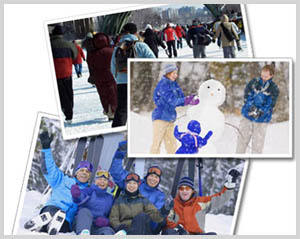Logged and tagged: Geodata for digital photos and more
 Frankfurt - Now where was that photograph taken? Sorting through photos can put even the strongest of memories to the test when it comes time to recall the location associated with each snapshot.
Frankfurt - Now where was that photograph taken? Sorting through photos can put even the strongest of memories to the test when it comes time to recall the location associated with each snapshot.
Those who want to put their brain cells to other tasks can acquire a GPS logger. As little as 50 dollars are required to buy the devices, which record the location of the photographer at all times but are no bigger than a matchbook. Software then adds the location into the meta-data (EXIF) for the images.
This "geo-tagging" offers a variety of new possibilities for archiving and presenting photos. The position data can be used to find and display the spot where photos were snapped on digital maps like Google Maps, Earth, or Panoramio.
Photographers can use coordinates to navigate their friends to the most hard-to-reach places. "You can also simply look up the coordinates in Wikipedia," says Constanze Clauss from Germany's Photo Industry Association (PIV). That helps you recall the name of sites and places you might have forgotten - and help provide information for captions and commentary on online photo albums.
Map-based online albums can be created at sites like www. locr. com or Google's Picasa. Flickr can also display tagged photos on a map. Another option is to use the GPS logger to record a hiking or bike path - recording the geodata "tracks" - and then show them on pages like GPSies. com, Gps-tour. info, Everytrail. com, Hikr. org, or Bikemap. net.
Tracks created with the GPS logger can also be included in the OpenStreetMap (OSM) digital mapping project. Users simply upload their tracks into the database at Openstreetmap. com. Those recordings are then helpful if you don't want to spend your time entering the street into the OSM system or drawing a map yourself, according to those involved in the OSM project.
Most loggers include software to synchronise the date and time of a photo with the same data and time in the GPS track. Free versions of that software are available at http://ww.locr.de/downloads. It is crucial for geodata to be assigned properly so that the camera's clock can be set accurately.
It is occasionally helpful to look at the status LED on the GPS logger to check that contact with the satellite hasn't been lost - and that the batteries still have juice. "You always have to give the device a little bit of time to link up with the satellites," Clauss recommends. Once the "fix" is established, the logger should also not stick the logger too deeply into a pocket or bag.
Cameras with GPS modules are rare. That is partially because the trackers are energy hogs. "The energy consumption on GPS devices is one problem, especially when you consider the size of camera batteries," notes the camera portal Digitalkamera. de. The bigger problem is that satellite fixes can last from 20 to 60 seconds or more.
GPS loggers have the advantage that they don't have to keep reconnecting to satellites. Most camera-independent loggers from makers like Holux, Royaltek, Wintec, Navilock, Winner Fly, or Hama include a standard battery and work from eight to ten charges. They connect to the computer via USB cable or wirelessly via Bluetooth.
Loggers with small displays also provide helpful on-the-fly information about location, speed, date, time, and free memory space. (dpa)